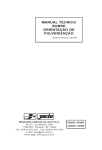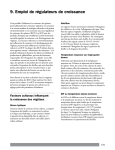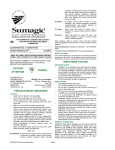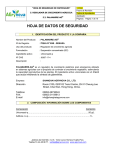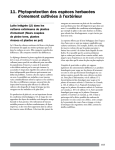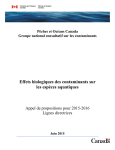Download USER GUIDE
Transcript
NE W Contains: 974 g/kg processed, refined and enhanced aluminium silicate in the form of a wettable powder - plus additional abiotic plant stress management compound. Dual Climate control for your crops Screen Duo is the latest generation development in Particle Film Technology with a dual activity to provide superior crop protection from environmental stress. Screen Duo also keeps your crop cooler which has a significant impact on water use efficiency and crop productivity. “Takes the environmental variability out of production” (Customer quote) USER GUIDE Dual Action - Stress Management Manufactured by Crop Microclimate Management Inc. PO Box 178, Apex. North Carolina. USA Distributed by Agricrop Pty Ltd ABN 84 100 473 309 255 Port Road Hindmarsh SA 5007 Phone: Agricrop 07-3348 4113 Fax: 07-3348 2702 David Bell - Technical enquiries 0417 501 503 www.agricrop.com.au/screenduo What is heat, light & water stress? Heat & light stress Heat and light stress are economically important problems in agricultural production primarily in hot climate countries – although even in more temperate regions, wide fluctuations in temperature or light intensity, can lead to significant damage. Heat and light stress cause losses by reducing overall plant productivity and quality. The most commonly observed symptoms are wilted or otherwise unhealthy looking plants and physical injury to limbs, leaves and fruits, generally referred to as ‘sunburn’. The symptoms are caused initially by damage to the photosynthetic apparatus, followed by damage to other tissues. Water stress Water stress is complex as it is not only a stand-alone problem, but is intricately involved with heat and light stress. Shortage of soil water can initiate and exacerbate heat and light stress. When soil moisture is limiting, a plant’s ability to cool itself through transpiration is impaired. Stomata are closed and leaf temperature increases. The photosynthetic machinery closes down and the plant is no longer able to process the light energy entering its cells. This leads to photoinhibition, a build up of free radicals (oxidants) and ultimately to tissue destruction and cell death i.e. the symptoms of heat and light stress damage. In the case where heat stress is initiated by high temperature, the plant will attempt to cool itself by means of increased transpiration. Once the soil moisture becomes limiting the same sequence of events as described above will take place. When to apply Screen Duo Using Screen Duo for sunburn and heat stress reduction Screen Duo may increase plant vigour and yield in many crops. Under high ambient temperatures, Screen Duo reduces canopy temperature and can therefore reduce heat and water stress. Screen Duo may improve fruit quality by improving colour, Brix/TSS, size and skin smoothness. Screen Duo will also reduce russet, flower and fruit abortion and cracking in certain crops. Using Screen Duo for sunburn management: Apply to sunburn-prone fruit, leaf, limb and trunk surfaces before conditions leading to sun damage occur. Apply initial application at full rate and a second at half rate at no more than a 7 to 10 day interval. Subsequent applications may be made at half rate (but do not reduce volume). Depending upon the length of the heat period, repeat applications may be needed at intervals of 7 to 21days. Using Screen Duo for heat stress management (crop (water use management): For heat stress reduction, spray plants with a full rate of Screen Duo based upon the Season-Long rate schedule found in the crop tables on pages 6 & 7. Make applications to maintain film coverage and to treat new growth. These applications also help reduce crop water usage by reducing crop temperature and transpiration. Independent trial results indicate that the use of Screen Duo can improve soil moisture status by as much as 25%. Screen Duo reflects damaging UV and IR radiation and heat, while still allowing photosynthesis and the uptake of nutrients and crop protection products SCREEN DUO - DIRECTIONS FOR USE Before using this product, read the directions in Post-harvest Packing and Washing on page 8. GENERAL INFORMATION Screen Duo crop protectant forms a reflective particle film intended for protection of agricultural crops and plants in nurseries and greenhouses. When Screen Duo is applied to plants, a dry white film results. Thorough, uniform, and consistent coverage is essential throughout the stress period. Application timing: Screen Duo can be used anytime from planting through to Post Harvest. If white residues at harvest are a concern, refer to the instructions under Post-harvest Packing and Washing directions. Plant response precautions: Screen Duo keeps plant surfaces cooler and an advance or delay in maturity may result. Pome and stone fruit may have maturity delays of 3 to 7 days, especially in cool regions or cool seasons. Mix instructions: For agitating sprayer tanks 1. Slowly add Screen Duo into the water in a recirculating sprayer tank, making sure to keep agitation brisk. Sprayer tanks with strong agitation are preferred. A pre-mix tank may speed up loading operations if sprayer does not have mechanical agitation. Add directly into the mix basket if pump recirculation empties into the mix basket. If there is no mix basket, add Screen Duo very slowly to the recirculating water. Avoid dumping Screen Duo directly into the pump intake area as this could plug the filter or intake. Mix thoroughly. 2. Add tank mix pesticides and adjuvants after the Screen Duo. 3. Continue agitation until the tank is empty. 4. At the end of the application flush system and nozzles with fresh water. Periodically check in-line strainer and clean if necessary. Properly dispose of rinse water. For non-agitating sprayer tanks, such as handheld and backpack sprayers The following mixing sequence must be followed: 1. Use Screen Duo at a rate of 12.5 to 25 gm of Screen Duo per one litre of water. For sprayers difficult to shake, premix in a bucket per the directions below and pour suspension into sprayer. 2. Add Screen Duo to sprayer 1/4 to 1/2 filled with water. Close top and shake vigorously. Add remaining water and shake to mix, as well as break up any remaining small clumps of Screen Duo, if found. It is not recommended to fill with a hose or shake the container while Screen Duo is floating on top of the water. 3. Mix thoroughly by shaking the closed container vigorously for 30 seconds. 4. Add tank mix pesticides and adjuvants after the Screen Duo. 5. Add the remainder of batch water and shake the closed container for an additional 30 sec. 6. If sprayer is motionless for 1 minute or more, shake sprayer to agitate product. 7. At the end of the application, spray until empty and flush system and nozzles. If not empty, blow air pressure out of the line and nozzle (usually by upending) and store in a cool place. Apply any leftover mix within two to three weeks to avoid spoilage. Rinse the sprayer and allow to dry before the next batch. Rates: Unless otherwise specified in crop instructions, use 0.625 to 2.5 kg of Screen Duo per 100Lt of water, using sufficient spray volume to obtain thorough near-drip coverage. Two or more applications may be required for complete coverage. Apply an additional spray if coverage is insufficient. Spreading on waxy plant surfaces is usually better when the plant surface is warm. Heavy rainfall, new growth, and wind erosion will affect film quality. Reapply to re-establish coverage after heavy rain as soon as the foliage is dry. Avoid excessively thick coatings. Foliage dryness: Applications to wet foliage can cause inadequate film formation as well as excessive run off. Under hot, dry conditions: Under very hot and dry conditions, increase volume of water and droplet size to improve deposition. Spray methods: Air blast, high-pressure handgun, or boom sprayers provide the best results. At given concentrations, the flow rate of suspended Screen Duo is similar to water. Strainers, preferably no finer than 40 mesh, in the spray system and behind each nozzle per normal practice helps to reduce nozzle clogging. A visual inspection of film deposition and completeness of coverage is crucial for fine-tuning spray coverage. Overhead irrigation and overhead cooling: Do not apply Screen Duo through any type of irrigation system. Overhead irrigation is not preferred over Screen Duo treated surfaces. Do not use with overhead cooling. Non-Target surfaces: Do not spray where the resulting visible white film will be undesirable or cannot be washed off, such as porous wood, masonry, asphalt, and valuable goods. General application guidelines Application guidelines for tree crops: Apply with an air blast sprayer calibrated to deliver the required volume based on Tree Row Volume. The equipment should be adjusted so that the spray is evenly distributed throughout the trees. Calculation of spray volumes based on tree row volume: The tree row volume is calculated as follows: TREE ROW VOLUME = 10 times (HEIGHT of TREE in METRES) times (WIDTH of TREE in METRES) divided by (BETWEEN ROW SPACE in METRES). Dilute spraying • Use a sprayer designed to apply high volumes of water to obtain near-drip coverage. Do not apply to the point of run-off. • Set up and operate the sprayer to achieve even coverage throughout the crop canopy. • The required water volume should be calculated using Tree Row Volume or by referring to industry guidelines or expert advice. • Add the amount of product specified in the Directions for Use table for each 100 L of water. Spray to near-drip. NB: A visual inspection of film deposition and completeness of coverage is crucial for finetuning spray coverage. Dilute spray volumes: The DILUTE SPRAY VOLUME in LITRES per HECTARE is calculated as follows: DILUTE SPRAY VOLUME = (TREE ROW VOLUME) times (SPRAY VOLUME FACTOR). The spray volume factor for trees of high foliage density is 125. Screen Duo provides a uniform coverage of leaf surfaces to protect the plant from sunburn and heat stress. Concentrate spraying • Use a sprayer designed and set up for concentrate spraying (that is a sprayer which applies water volumes less than those required to reach near-drip) and matched to the crop sprayed. • Set up and operate the sprayer to achieve even coverage to the canopy exterior using your chosen water volume. • Determine an appropriate dilute volume (See Dilute Spraying directions) for the crop canopy. This is needed to calculate the concentrate mixing rate. Do not apply at a concentration of greater than 4X. NB: A visual inspection of film deposition and completeness of coverage is crucial for finetuning spray coverage. Concentrate spray volumes: Concentrate sprays are applied at lower water volumes and higher concentrations than dilute sprays. The CONCENTRATION FACTOR of these sprays is the NUMBER OF TIMES they are MORE CONCENTRATED THAN THE DILUTE SPRAY. The mixing rate for concentrate spraying can be calculated in the following way. EXAMPLE ONLY: (i) Calculate the DILUTE SPRAY VOLUME as above. For example 1500 L/ha. (ii) Your chosen concentrate spray volume: For example 750 L/ha. (iii) The concentration factor is: 2X (i.e. 1500 L / 750 L = 2). (iv) If the dilute rate is 2.5 kg/100 L, then the concentrate rate becomes 2 x 2.5 kg; that is 5 kg/100 L of concentrate spray. For further information on concentrate spraying, users are advised to consult relevant industry guidelines or seek expert advice. Screen Duo has shown excellent spread and adhesion to foliage and fruit Screen Duo - usage rates and comments TREE CROPS Rate Comments Pome and Stone Fruits, Nut crops, Olives, Grape vines, small fruits including berries. Season Long (Preferred) Apply the first two applications 7 to 10 days apart and prior to the first heat event. Apply in a water volume according to Tree Row Volume. Refer to Application Guidelines. Apply initial application of 1.25 kg/100 L water beginning at petal fall (cap fall), followed by subsequent applications of 0.625kgs per 100 L water every 10-14 days Tropical and Subtropical crops such as Avocado, Banana, Mango, Guava, Papaya, Paw Paw or 1.25 kgs per 100L water every 14-21 days. Nursery & Ornamental plants Late Season Program Citrus Fruits If rainfall or high temperatures occur, reapply Screen Duo to refresh film. 1. Initial application 2.5 kg/100L 2*. Subsequent applications at 10 to 14 day intervals at 1.25 kgs/100L On hard to wet foliage and fruit such as mangoes, plums and grape vines add a non-ionic surfactant/spreader at the recommended spreader label rate to the initial spray, or when reapplying after the film has worn off. Cherries: Apply post-harvest only. *At low rates of Screen Duo and at high water volumes it is necessary to add additional surfactant/spreader at the recommended spreader label rate. Citrus – due to the excellent ability of Screen Duo to stick to citrus leaves and foliage the application rate of subsequent applications is 0.625 kgs/100 L at 14 to 21 day intervals Screen Duo - usage and effect on wine grapes The AWRI was contracted to assess if there was any impact from the use of Screen Duo on wine quality and production. The following extract is taken from their report conclusion. “The application of Screen Duo is considered to have a very minor impact on fermentation onset but fermentation rates and completion were unaffected. No detrimental impact on red wine colour and aluminium levels was shown by the treatment. Sensory analysis demonstrated no obvious faults or taints but a minor difference was noted when comparing the untreated control and the wines from this treatment.” For further information on the AWRI report, contact your Agricrop representative. Screen Duo - usage rates and comments FIELD CROPS Rate Season-Long (Preferred) 6.25 kg/ha beginning just prior to Capsicums, flowering. Tomatoes, Potatoes, Onions, Re-apply at 7 to 14 Cucurbits such as day intervals. Vegetable crops including : Cucumber Squash, Pumpkin, Rock melon, and Watermelon. Vegetable Seedlings Late Season Sunburn/Heat Management Initial application 25 kg/ha Subsequent applications 12.5 kg/ha Comments Apply the first two applications 7 to 10 days apart and prior to the first heat event. Increase the volume of water used throughout the season based upon plant size. Re-apply at 7 to 14 day intervals as required to maintain an even coverage on the fruit and foliage. Continue treatment as required and maintain cover up to 7 days prior to harvest. Cucurbits: apply to smooth-skinned cucurbits only. Refer to Postharvest Packing and Washing instructions in this booklet. Ensure that fruit is well covered for greatest sunburn reduction. Reduces transplant shock and heat stress when planting greenhouse raised transplants out in the field. Apply in a water volume of approximately 1000 to 1250 L/ha using a calibrated boom fitted with fan nozzles. Applications near harvest are needed if the ripening fruit changes position as its weight increases. Heavy rainfall, new growth and wind erosion will affect film quality. Reapply to re-establish cover-age after heavy rain as soon as the foliage is dry. If the entire cover is lost due to rain, recommence applications at the initial high rate, followed bysubsequent applications at the lower rate. Pineapple For fresh market pineapple, ensure that high pressure forced water sprays adequately remove white residue per the instructions under ‘Post-harvest Packing and Washing’ on page 6. Cotton, Peanuts Season-Long 6.25 kg/ha beginning just prior to flowering. Re-apply at 7 to 14 day intervals. For the management of heat stress. Re-apply as required at 7 to 14 day intervals depending on growth dilution and rainfall. Post-harvest packing and washing directions Crops that will be processed Thorough washing is not generally required for crops to be processed, as light residues of Screen Duo do not affect the quality of processed products. Crops that have their skin or treated surface removed in processing, and crops that only have traces remaining at harvest, generally do not need to be washed. Check with processor before use to ensure Screen Duo treated produce is acceptable for processing. Crops for fresh market Post-harvest washing is required unless only early-season applications are made. Most residues wash off with packing line brushing and forced water sprays. First time users must do a small-scale field application and post harvest film removal trial before commercial use on fresh market crops to determine if residues can be sufficiently removed. Traces of Screen Duo white film deposits may still be visible after washing, particularly in difficult to brush areas of the produce (e.g., calyx, stem end, creases etc). Modifications to the packing line may be necessary to improve film removal. Modifications considered could include; Higher pressure nozzles and nozzle types, warm water, longer soak period in the dump tank, use of different brush types; including longer haired or sculptured brushes, adjustment of brush rotation speed, overhead and additional brushes in the brush bed. Produce movement though the washing and brushing process can also be slowed. Produce that shows traces of white film after a single pass through the washing process should be washed again. Waxing further improves fruit appearance. The use of a fresh produce washing detergent that is labelled for use in the packing line and/or wash tank may assist in film removal. The detergent would need to be cleared for this purpose by the relevant authorities and potential buyers. For fresh market crops that will not be waxed, such as fruit for organic markets or specific export markets that do not accept waxed fruit or for washed crops where traces of Screen Duo residue are not acceptable: Unless washing facilities are adequate, cease applications sufficiently in advance of harvest to allow residue to weather off completely. For “Red Delicious” and “Braeburn” apple varieties do not apply any later than two months prior to harvest. For fresh market crops that will not be washed or for field packed crops where a residual film is not desired: Do not use this product. Special washing considerations for stone fruit: Special washing is required for fresh market fruit; especially for fuzzy peaches. Most residues wash off with brushing and forced water sprays. An approved fruit cleaning detergent may be used in the packing line and/or wash tank. Prior to brushing, a pre-soak in approved fruit cleaning detergent is usually needed for fuzzy peaches. A preharvest washing trial is a good practice to determine if a detergent is necessary. If fresh market peaches cannot be washed as noted above, discontinue sprays when the fruit are approximately 3 cm in diameter. Residues of Screen Duo do not affect processed fruit quality. Screen Duo compatibility guide General Screen Duo is made from a very pure form of kaolin, which is an inert mineral with neutral pH and can be tank-mixed with most commercially available crop protection and foliar nutrition products. CMM has not tested every product in the market and therefore cannot state that Screen Duo is either physically or biologically compatible with all of them and it is the responsibility of the user to test any planned tank-mix combination before large scale use. Such a test will quickly reveal if there is any interaction between Screen Duo and the tank-mix product – e.g. precipitation or poor spray deposition. Note: always add Screen Duo first and ensure complete suspension in the water before adding any other product. Maintain agitation throughout the mixing and spraying operations. Mixing order: 1. Commence filling the spray tank with water and commence agitation. Good agitation is essential. 2. Screen Duo must be added to the tank before any other product. 3. Ensure that the Screen Duo is fully dispersed in the spray tank prior to adding any other product. 4. Add the additional product (refer to label for mixing instructions). 5. Continue good agitation whilst spraying. Tank-mix products or combinations that are not recommended include: • Products that are not formulated for agricultural use e.g. elemental sulphur, bentonite, diatomaceous earth. • Anti-foaming agents – these may impact Screen Duo film formation. • Products that require application in very high volumes of water or with very high application pressures. • Oversprays with latex, wax, polymer or mineral products. • ReTain® - do not tank-mix with Screen Duo or use ReTain® on Screen Duo treated trees. Screen Duo should be generally compatible with the following commonly used pesticides Amistar® Avatar® Avid® - abamectin Bulldock® 25EC - Beta-cyfluthrin Calcium sprays Calypso® 480 SC - thiacloprid Captan Carbaryl Chlorthalonil Chorus® - cyprodinil Confidor® 200 SC- imidicloprid Copper OxyChloride Delan® - dithianon Diazinon Dimethoate Dipel™ DF Dithane Dodine Endosulfan Gusathion® - azinphos-methyl Kocide® - cupric hydroxide Lorsban®WP – clorpyrifos Lorsban® EC Mancozeb Methomyl Methyl Parathion Nipro Cal-Nite Norshield Omite® - propargite Paramite® Phosmet Polyram® - metiram Proclaim® - imamectin Pyranica® - tebufenapyrad Rovral® - iprodione Rubigan® - Fenarimol Saprol® - triforine Secure® 360 SC - chlorfenapyr Spraying Oils** Success® - Spinosad Sumisclex® - procymidone Sunny® - Uniconazole-P Sulphur (Wettable types only, not unformulated elemental types) Systhane® - myclobutanil Sumi-Alpha Flex® - Esfenvalerate Talstar® - bifenthrin Tilt® 250 EC - propiconazole Zinc sprays Note 1. Use of brand names does not mean that CMM endorses that brand or that the manufacturer of that brand endorses the tank-mix of their product with Screen Duo. Note 2. Tank-mixes in oversprays with oil products may reduce the visibility. Note 3. TM, ® Refer to manufacturer product labels for trade mark references. Crop Microclimate Management Inc. (CMM) researches, develops, manufactures and markets products and services to farmers for the management of ‘abiotic’ or environmental stresses in crop plants. CMM’s products are tools that allow farmers to cost-effectively reduce losses in yield and harvest quality that result from plants being exposed to excessive heat, cold and light or suffer from a shortage of water in combination with excessive heat. In many crops, abiotic stresses consistently result in losses from 10-50% of potential marketable yield. For further information on Crop Microclimate Management Inc. visit www.cropstress.com PRECAUTIONARY STATEMENTS: Causes slight eye irritation. Avoid contact with eyes. May cause irritation to the respiratory system. Avoid breathing dust or mist. PERSONAL PROTECTIVE EQUIPMENT: Applicators and other handlers should wear a dust/mist-filtering respirator. Nuisance dust masks and goggles are recommended for harvesters especially when plants are shaken during harvest. FIRST AID: If in eyes, hold eyes open and flood gently with water. For further information refer to the Material Safety Data Sheet. STORAGE AND DISPOSAL: Do not contaminate water, food, or feed by storage and disposal. PRODUCT STORAGE: Store in a dry, sheltered location. Product is slippery when wet. In case of spill or leak, avoid breathing dust, clean up and dispose of wastes in compliance with applicable local regulations. PRODUCT DISPOSAL: Spray mixture or rinsate that cannot be used according to label instructions must be disposed of according to applicable local procedures. CONTAINER DISPOSAL: Completely empty bag into application equipment. Dispose of empty bag according to local regulations. ENVIRONMENTAL HAZARDS: Do not contaminate water when disposing of equipment wash water. CONDITIONS OF SALE: Agricrop Pty. Ltd. “Agricrop” and Crop Microclimate Management Inc. “CMM” shall not be liable for any loss injury damage or death whether consequential or otherwise whatsoever or howsoever arising whether through negligence or otherwise in connection with the sale supply use or application of this product. The supply of this product is on the express condition that the purchaser does not rely on Agricrop” or CMM”s skill or judgement in purchasing or using the same and every person dealing with this product does so at his own risk absolutely. No representative of Agricrop or CMM has any authority to add to or alter these conditions. Agricrop and CMM neither intends, nor do they authorize any agent or representative to make any other warranty, expressed or implied, and they expressly exclude and disclaim all implied warranties of merchantability or fitness for a particular purpose. Retain® is a registered trademark of Valent BioSciences Corporation U.S.A. Raynox® is a registered trademark and product of FruitGard LLC. U.S.A. Screen Duo™ is a registered trademark of Crop Microclimate Management Inc. Dual Action - Stress Management Dual activity - More protection • Increased quality and size of fruit and veggies • Improved Brix/TSS • Crops shed less fruit • Reduced flower abortion • Reduced bi-annual bearing • Reduced twinning in cherries with post harvest application • More efficient water use Block out sunburn and LOCK IN YIELD • Increased marketable yield • Reduced russet • Higher pack outs • More dollars in your pocket Screen DUO gives you the advantage of:• Reduced cost per hectare • Improved rain fastness • Reduced rate per hectare • Easier handling and mixing Your local Screen Duo outlet:












